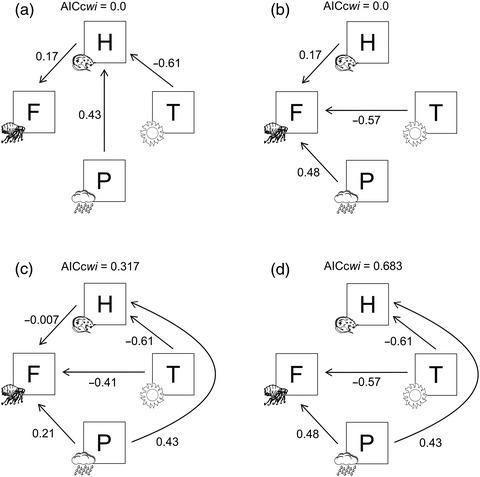当前位置:
X-MOL 学术
›
J. Anim. Ecol.
›
论文详情
Our official English website, www.x-mol.net, welcomes your feedback! (Note: you will need to create a separate account there.)
Harrison’s rule scales up to entire parasite assemblages but is determined by environmental factors
Journal of Animal Ecology ( IF 4.8 ) Pub Date : 2020-10-05 , DOI: 10.1111/1365-2656.13344 Renan Maestri 1 , Maico S Fiedler 1 , Georgy I Shenbrot 2 , Elena N Surkova 3 , Sergei G Medvedev 4 , Irina S Khokhlova 5 , Boris R Krasnov 2
Journal of Animal Ecology ( IF 4.8 ) Pub Date : 2020-10-05 , DOI: 10.1111/1365-2656.13344 Renan Maestri 1 , Maico S Fiedler 1 , Georgy I Shenbrot 2 , Elena N Surkova 3 , Sergei G Medvedev 4 , Irina S Khokhlova 5 , Boris R Krasnov 2
Affiliation

|
Harrison's rule states that parasite body size and the body size of their hosts tend to be positively correlated. After it was proposed a century ago, a number of studies have investigated this trend, but the support level has varied greatly between parasite/host associations. Moreover, while the rule has been tested at the individual species level, we still lack knowledge on whether Harrison's rule holds at the scale of parasite and host communities. Here, we mapped flea (parasites) and rodent (hosts) body sizes across Mongolia and asked whether Harrison's rule holds for parasite/host assemblages (i.e., whether a parasite's average body size in a locality is positively correlated with its host's average body size). In addition, we attempted to disentangle complex relationships between flea size, host size, and environmental factors by testing alternative hypotheses for the determinants of fleas' body size variation. We gathered occurrence data for fleas and rodents from 2370 sites across Mongolia, constructed incidence matrices for both taxa, and calculated the average body sizes of fleas and their hosts over half-degree cells. Then, we applied a path analysis, accounting for spatial autocorrelation, trying to disentangle the drivers of the correlation between parasite and host body sizes. We found a strong positive correlation between average flea and host size across assemblages. Surprisingly though, we found that environmental factors simultaneously affected the body sizes of both fleas and hosts in the same direction, leading to a most likely deceptive correlation between parasite and host size across assemblages. We suggest that environmental factors may, to a great extent, reflect the environmental conditions inside the hosts' burrows where fleas develop and attain their adult body size, thus influencing their larval growth. Similarly, rodent body size is strongly influenced by air temperature, in the direction predicted by Bergmann's rule. If our findings are valid in other host-parasite associations, this may explain the dissenting results of both support and lack thereof for Harrison's rule.
中文翻译:

哈里森法则可扩展到整个寄生虫组合,但由环境因素决定
哈里森法则指出,寄生虫的体型与其宿主的体型往往呈正相关。一个世纪前提出后,许多研究调查了这一趋势,但寄生虫/宿主协会之间的支持水平差异很大。此外,虽然该规则已在单个物种级别进行了测试,但我们仍然缺乏关于哈里森规则是否适用于寄生虫和寄主社区规模的知识。在这里,我们绘制了整个蒙古的跳蚤(寄生虫)和啮齿动物(宿主)的体型大小,并询问哈里森的规则是否适用于寄生虫/宿主组合(即,一个地方的寄生虫的平均体型是否与其宿主的平均体型呈正相关) . 此外,我们试图解开跳蚤大小、寄主大小、通过测试跳蚤体型变化的决定因素的替代假设,以及环境因素。我们收集了来自蒙古各地 2370 个地点的跳蚤和啮齿动物的发生数据,构建了这两个类群的发生率矩阵,并计算了半度细胞内跳蚤及其宿主的平均体型。然后,我们应用了路径分析,考虑了空间自相关,试图解开寄生虫和宿主体型之间相关性的驱动因素。我们发现跨组合的平均跳蚤和宿主大小之间存在很强的正相关。但令人惊讶的是,我们发现环境因素同时影响同一方向的跳蚤和宿主的体型,导致寄生虫和宿主大小之间最有可能存在欺骗性的相关性。我们认为,环境因素可能在很大程度上反映了宿主洞穴内跳蚤发育并达到成年体大小的环境条件,从而影响了它们的幼虫生长。同样,啮齿动物的体型受气温的强烈影响,按照伯格曼法则预测的方向。如果我们的发现在其他宿主-寄生虫协会中是有效的,这可能解释了对哈里森规则的支持和缺乏支持的不同结果。
更新日期:2020-10-05
中文翻译:

哈里森法则可扩展到整个寄生虫组合,但由环境因素决定
哈里森法则指出,寄生虫的体型与其宿主的体型往往呈正相关。一个世纪前提出后,许多研究调查了这一趋势,但寄生虫/宿主协会之间的支持水平差异很大。此外,虽然该规则已在单个物种级别进行了测试,但我们仍然缺乏关于哈里森规则是否适用于寄生虫和寄主社区规模的知识。在这里,我们绘制了整个蒙古的跳蚤(寄生虫)和啮齿动物(宿主)的体型大小,并询问哈里森的规则是否适用于寄生虫/宿主组合(即,一个地方的寄生虫的平均体型是否与其宿主的平均体型呈正相关) . 此外,我们试图解开跳蚤大小、寄主大小、通过测试跳蚤体型变化的决定因素的替代假设,以及环境因素。我们收集了来自蒙古各地 2370 个地点的跳蚤和啮齿动物的发生数据,构建了这两个类群的发生率矩阵,并计算了半度细胞内跳蚤及其宿主的平均体型。然后,我们应用了路径分析,考虑了空间自相关,试图解开寄生虫和宿主体型之间相关性的驱动因素。我们发现跨组合的平均跳蚤和宿主大小之间存在很强的正相关。但令人惊讶的是,我们发现环境因素同时影响同一方向的跳蚤和宿主的体型,导致寄生虫和宿主大小之间最有可能存在欺骗性的相关性。我们认为,环境因素可能在很大程度上反映了宿主洞穴内跳蚤发育并达到成年体大小的环境条件,从而影响了它们的幼虫生长。同样,啮齿动物的体型受气温的强烈影响,按照伯格曼法则预测的方向。如果我们的发现在其他宿主-寄生虫协会中是有效的,这可能解释了对哈里森规则的支持和缺乏支持的不同结果。



























 京公网安备 11010802027423号
京公网安备 11010802027423号